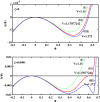On the morphology of electrostatic solitary waves in the Earth's aurora
- PMID: 36307517
- PMCID: PMC9616873
- DOI: 10.1038/s41598-022-23095-y
On the morphology of electrostatic solitary waves in the Earth's aurora
Abstract
Electrostatic solitary waves (ESWs) have been detected in abundance in Space plasma observations, both by satellites in near-Earth plasma environments as well as by planetary missions, e.g. Cassini in Saturn or MAVEN in Mars. In their usual form, these are manifested as a bipolar electric field corresponding to a bell-shaped pulse in the electrostatic potential. Recent studies have suggested the existence of alternative forms of ESWs, including flat-top solitary waves (FTSWs) and supersolitary waves (SSWs), both of which are often encountered in Space observations such as in polar cap boundary layer, the auroral acceleration region and elsewhere. This article focuses on the existence and characterization of different types of electrostatic solitary waves in multicomponent Space plasmas. Relying on a multi-fluid plasma model, comprising two types of ions and two different electron populations, we have identified the conditions for existence of flat-top solitary waves and supersolitons, in contrast to "standard" solitary waves. Both ion species are models as cold fluids, for simplicity. Our analysis reveals that the coexistence of the two electron populations is pivotal for the formation of such non-standard electrostatic structures, and that their characteristic parameters (temperature, density ratio) plays a decisive role in their generation and structural characteristics. Nonetheless, while supersolitary waves may exist in a wide range of parameter values (as confirmed by earlier theoretical studies), it appears that flat-top solitary waves will occur in a narrow window in the parameter region, which may explain their scarce (but non-negligible) frequency of observation. Our theoretical findings confirm and validate the existence of alternative (non-conventional) ESW waveforms in auroral plasma (in addition to the ubiquitous bipolar electric field form), where such an electron coexistence is typically observed.
© 2022. The Author(s).
Conflict of interest statement
The authors declare no competing interests.
Figures














References
-
- Temerin M, Cerny K, Lotko W, Mozer FS. Observations of double layers and solitary waves in the auroral plasma. Phys. Rev. Lett. 1982;48:1175–1179. doi: 10.1103/PhysRevLett.48.1175. - DOI
-
- Tsurutani B, et al. Plasma waves in the dayside polar cap boundary layer: Bipolar and monopolar electric pulses and whistler mode waves. Geophys. Res. Lett. 1998;25:4117–4120. doi: 10.1029/1998GL900114. - DOI
-
- Pickett J, et al. Furthering our understanding of electrostatic solitary waves through cluster multispacecraft observations and theory. Adv. Space Res. 2008;41:1666–1676. doi: 10.1016/j.asr.2007.05.064. - DOI
-
- McFadden JP, et al. Fast observations of ion solitary waves. J. Geophys. Res. Space Phys. 2003;108:1. doi: 10.1029/2002JA009485. - DOI
-
- Dauxois T, Peyrard M. Physics of Solitons. Cambridge University Press; 2006.
Grants and funding
LinkOut - more resources
Full Text Sources
Miscellaneous

